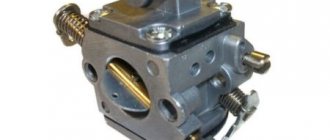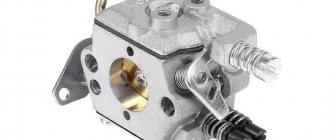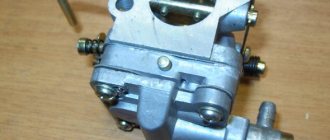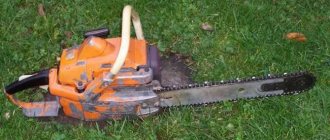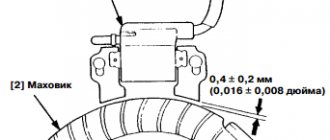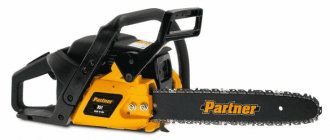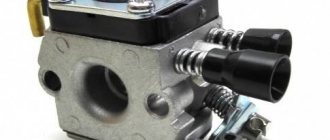The carburetor of the internal combustion engine of the Carver chainsaw is responsible for supplying the correctly dosed fuel-air mixture. By increasing the mixture supply when pressing the throttle, engine speed increases. Stable idle speed also depends on proper carburetor operation. This is an important chainsaw system and you need to have an understanding of how it works, know the basics of diagnostics, and also be able to adjust and repair it.
The first signs of a carburetor malfunction
Due to untimely or unprofessional repeated maintenance of the chainsaw, also due to heavy load, difficulties in its operation may at times appear. For professional workers, such breakdowns can reduce the efficiency of their work and spoil their mood for the whole day.
Carburetor malfunctions, in turn, have special symptoms. Using them you can immediately find the cause of the breakdown.
The following signs indicate an incorrect carburetor setting:
- The tool starts up problematically, then immediately stalls.
- The chainsaw stalls when you press the gas.
- Gasoline is consumed in large quantities, and it still remains in the cylinders and does not burn out completely, and the exhaust is extremely thick.
- The carburetor options installed at the manufacturer's factory have been knocked down due to incorrect use or self-adjustment.
- Debris has entered the air intake system. Because of this, she failed.
- The engine pistons are used up. Tuning the carburetor in this case will only temporarily solve the problem.
In this case, when dirt gets into the carburetor, one adjustment is not enough. Here you just need to clean it. When the pistons are used up, a complete engine overhaul is required.
But after that, of course, it is necessary to adjust the carburetor jets, as well as purge and clean them.
STIHL saws and Partner
In chainsaws STIHL 250, 361, also Partner 351, 350, the carburetor is adjusted using screws H and L by setting the proportions of gasoline and air. If you release them, then a large part of the fuel will be added and therefore the speed will be high, otherwise, on the contrary, it will drop.
Idle speed in Partner chainsaws is regulated using a screw with the letter T, and in Shtil, it is usually necessary to find the aircraft marking. Standard adjustment of the chainsaw is carried out during finishing tests. Basically, after such options, the percentage of fuel in the working mixture is greater than air, which does not correspond to good characteristics. But they need to be saved during the first hours of operation during the running-in of the device. After which the saw can be adjusted independently, but it will work perfectly even on industrial settings.
But if it is decided to regulate without the help of others, then the actions must be performed in the following sequence:
- adjusting screw L;
- later adjust the jet H;
- then proceed to adjusting the idle speed using screw T (if chainsaw is LA).
At first, screw L must be turned in both directions in order to find the highest engine speed. If that point is found, then turn the same screw by ¼, slowing down the speed a little. If, despite all this, the chain continues to move at idle, you must immediately turn screw T (LA) until the chain stops completely.
After selecting the highest speed with screw H, you need to check the frequency on the tachometer. In this case, when it does not correspond to those indicated in the service book, the setting must be repeated. When at high speeds a lot of smoke comes out of the exhaust pipe, then the mixture is very rich in fuel; if noise is heard and the engine gets very hot, then on the contrary, it is lean. Later you need to adjust the idle speed. With the correct setting, you should experience a smooth sound from the engine at low speeds, while the chain should not move.
Chainsaw Carver 245 – model characteristics
The Carver RSG-245 chainsaw is equipped with a high-quality gasoline engine that fully meets EPA EU-II standards. The engine is equipped with proprietary Clean2 and AfterCharge fuel saving systems, which reduce fuel consumption by approximately 10%.
Features of this Carver brand tool include:
- rated power of the factory internal combustion engine is 2.2 liters. With.;
- the permissible length of the tire used is 35–40 cm;
- saw set pitch – 0.325 “;
- chain rotation speed at maximum engine speed is 12500 rpm.
For greater operator safety, the manufacturer has equipped the Carver garden tool with a reliable chain brake that is activated by inertia with every significant impact on a hard object.
Operating principle
The purpose of the carburetor is to prepare a working mixture for feeding it into the engine cylinders. This consistency is gasoline and air in proportions suitable for engine operation. If this ratio is violated, the engine will not work smoothly. When the mixture contains a lot of gasoline, then in layman's terminology it is called saturated, and if, on the contrary, there is not enough, then it is called lean. But in any case, a failure in the proportions of the working consistency will have a bad effect on performance.
Different models of chainsaws may have different carburetor designs, but according to the principle of operation they are all similar. Air moves through a special channel at a speed that can be adjusted by closing or opening the damper. Gasoline, in turn, enters the carburetor through jets and mixes with air there, creating a special mixture that enters the engine.
The pressure in the float compartment of the carburetor, where gasoline is present before mixing, is close to atmospheric. When you open the damper, there is more air, as well as gasoline, so the engine speed increases. All this creates a vacuum in the air channel and gasoline is drawn into the air flow. This is the principle of operation of the carburetor.
In order for the chainsaw to work smoothly and perfectly, and without having to consume a huge amount of fuel, its carburetor must be adjusted appropriately. Before such work, it is necessary to check the air and gasoline filters in advance. If dirt is found on them, they should be replaced.
Setting up a chainsaw for most models is usually done using three screws - high and low speed and idle speed.
adjusting the carburetor on a Chinese chainsaw
The following signs should indicate correct configuration:
- The chain should not move at idle.
- The motor runs smoothly.
- There should also be no interruptions in work at start-up.
Repairing a chainsaw carburetor with your own hands must be done very carefully, because no matter what mistake you make can lead to serious consequences, even before the engine completely breaks down. If you do not have enough experience, then it is better to seek the help of a specialist.
Process description
- If the chainsaw carburetor is not adjusted and it is not possible to start the chainsaw, then the adjustment begins by installing screws (L) and (H) to the standard setting position. This is 1/5 turn of the screws until they are fully tightened.
- After which, you need to start the engine, let it run a little and warm up.
- The next step is setting the low speed mode. Optimal engine operation at low end can be achieved by adjusting the screw (L) and idle speed (T). To do this, first screw (L) is tightened until maximum engine speed is reached, then released by 1/4, and screw (T) is used to return the idle speed to normal.
- After adjusting the operation at the “lower” range, the traction and maximum engine speed are adjusted. To do this, slowly tighten the screw (H) and check the speed using the readings of the electronic tachometer. It is unacceptable to exceed the maximum engine speed declared by the manufacturer!
Location of carburetor adjustment screws on a Husqvarna chainsaw.
An important step is to check the saw in all operating modes after adjustment; to do this, you need to let the chainsaw cool, and then start it according to the cold tool starting algorithm. If the saw starts up normally and idles smoothly, you need to check how it cuts. If during the inspection process shortcomings in the power of the chainsaw are discovered, then it is necessary to repeat the adjustment of the screw (H) by unscrewing it and checking the traction in operation.
We recommend watching a video on how to clean and adjust the carburetor
chainsaw, the author of which also talks about the harmful effects of fuel on the components of the carburetor. The example shows how to restore your carburetor using an inexpensive repair kit.
Adjusting the Carburetor of a Carver Chainsaw
The best information about adjusting carburetors on a chainsaw
Greetings to you dear and most faithful readers of my blog. In today's article, I decided to look at how to adjust the carburetor on a chainsaw. After all, it seems to me that you have more than once encountered the problem that your “darling” let you down when you needed it most. And since you and I are frugal and don’t want to spend money on something we can do ourselves, let’s learn how to adjust the carburetor on our chainsaws with our own hands, without involving professional repairmen. And as you'll soon see, it's quite easy to do. You don't even need to do anything special. I specifically examined the adjustment of carburetors of all well-known brands of saws, no matter which of which has its own tricks and qualities, and in my opinion this is the best information on the network!
READ The chain spins when starting the chainsaw
Is disassembly necessary?
You can adjust the carburetor of a chainsaw without any disassembly at all; in rare exceptions, you only have to remove the air filter cover. There is a lot of contradiction here: on the one hand, the chainsaw is designed for unhindered access to the adjustment mechanism, on the other hand, it is recommended to access it as little as possible.
True, experienced fellers and sawers always carry a flat-head screwdriver with a long blade and from time to time adjust the carburetor. This is explained simply: during the manufacture of a chainsaw, its carburetor undergoes rough adjustments designed for a certain composition of air and fuel. It is clear that the conditions at the work site are different from those on the bench.
When changing the brand of gasoline or, for example, increasing air humidity, the most experienced chainsaw user will always adjust the quality of the consistency for greater performance and less wear on the piston part. But this, we repeat, requires a lot of experience working with a particular chainsaw and knowledge of the peculiarities of its behavior. In addition, the adjustment is indescribably narrow - the screws are tightened only 1/10. 1/20 turn.
Another reason for adjustment is repairing or replacing the carburetor. In any case, adjustment of the mixture quality should be carried out only if the serviceability of the carburetor is reliably known (no debris, gaskets are not poisoned), the air filter is clean, the spark plug, clutch and ignition system are in perfect order. Otherwise, there is a high probability that the malfunction will be eliminated in a moment and the adjustment will suddenly become incorrect, and the engine will begin to wear out.
Main adjustment screws
There are only three organs for adjusting the carburetor; these are screws shunted by springs for a flat-head screwdriver. There is a pair of screws at the bottom, L on the left, H on the right. A little higher is the T (or S) screw. So here's what they are for:
- Screw L is the same valve that regulates the cross-section of the fuel channel when operating at low speeds.
- Screw H, by analogy with the previous one, is a channel flow regulator for high speeds.
- Screw T is the throttle valve adjuster. It determines its position when the accelerator lever is fully released.
The design of the first two adjusting screws is extremely simple: at their ends there are needles inserted into spools of variable cross-section (cones). All threads are right-handed, so by tightening the screw clockwise, you drive the needle deeper and reduce the flow. When rotating counterclockwise, the exact opposite happens.
In this way, the quality of the mixture is regulated in different operating modes. If the fuel increases, the gasoline does not have time to burn completely and the engine develops less speed. When the mixture becomes leaner, the speed, on the contrary, increases, and at the same time the engine temperature increases. It is worth noting that even when the screws are tightened all the way, the flow of both channels is not completely blocked, unless there is a blockage.
Elimination methods
The list of upcoming work on the engine may be as follows:
- replacing the fuel pump;
- disassembling and washing the strainer;
- replacing the adjustment lever;
- it is also necessary to clean the adjustment space;
- replacing the membrane (or the entire block where this membrane is located);
- adjusting intake, exhaust and needle valves;
- replacing dampers;
- cleaning fuel channels and diffuser;
- replacing screw springs;
- change of primer.
Not all of these jobs can be completed. It often turns out that many of them are not needed if a specific malfunction is immediately detected.
The design and principle of operation of a chainsaw carburetor
carburetor consists of the following main components:
- one-piece body made of light aluminum alloy;
- a diffuser located at the entrance to the carburetor;
- jets, special valves designed to regulate the supply of a combustible mixture;
- sprayer;
- float chamber.
Below is a diagram of a Walbro carburetor, which is very often equipped with chainsaws. Using this diagram, you can study in more detail the internal structure of the chainsaw carburetor.
The carburetor may have 2 or 3 adjusting screws with springs. The adjusting screws are designed so that there are needles (cones) at their ends. The screws have a right-hand thread, that is, they are tightened clockwise.
The chainsaw carburetor works as follows.
- After starting the engine, the air damper opens.
- In the diffuser (16), where there is a narrowing, the air flow accelerates and mixes with gasoline. The latter enters through jets (15) and (12), and the air purified by the air filter comes through the damper (7) located at the diffuser inlet.
- The damper (8), located behind the diffuser, regulates how much of the prepared mixture enters the combustion chamber.
- The volume of gasoline passing through the nozzles is regulated by screws (17) and (10) - these are, respectively, screws L and H on the chainsaw.
- The volume of the fuel mixture in the float chamber (14) depends on the needle valve (11). The functioning of the needle valve is controlled by a diaphragm (13).
- The membrane (4) controls the flow of the fuel mixture into the combustion chamber, and this depends on the number of revolutions of the internal combustion engine. Gasoline is purified through a filter (6).
Design features
Working comfort is increased due to good balance, improved vibration damper design, and a significant reduction in noise level.
Despite the significant improvement in performance characteristics, the price of the Carver 45-15 saw has increased slightly compared to previous proprietary designs.
The design of the chainsaw takes advantage of easy start systems and automatic chain lubrication with adjustable pump performance. The compact placement of internal equipment is combined with convenient access to the air intake filter, fuel system adjustment components and chain tensioning mechanism.
- combination of classic instrument layout with modern trends in industrial design;
- weights with power characteristics;
- simple maintenance with an extended service life between repairs.
Rules for setting up the carburetor
You should know that the carburetor can be adjusted correctly only if:
- cleaning filters (gasoline and air) are not dirty;
- the jets and the channels leading to them are clean;
- the membranes are not damaged;
- the needle valve is working properly and the required volume of fuel mixture enters the float chamber.
To adjust the carburetor of imported chainsaws, you must adhere to the following rules.
- Before adjustment, if possible, you should warm up the engine at idle or minimum speed for about 10-15 minutes.
- By rotating the “L” regulator, the engine is operated in such a way that it produces one and a half to two thousand revolutions per minute at idle. But you should pay attention to how the engine gains speed. When pressing the accelerator lever, acceleration should proceed quickly and evenly. If a “drop” in speed is detected, the screw should be slightly unscrewed until this phenomenon is eliminated, since it is caused by insufficient enrichment of the fuel mixture.
- When the mixture flow is adjusted at low speed, you should start tightening the screw “T” until you notice the rotation of the saw chain. After this, the screw should be unscrewed by half or a third of a turn, observing the behavior of the clutch mechanism. Normally, the saw should not rotate at idle speed.
Screw “H” compensates for under- or over-revving due to a change in fuel type, change in oil concentration or ambient air humidity.
Also, the “upper” setting can be lost if the low speed is incorrectly adjusted with the corresponding screw.
Without enough experience, it is better not to adjust the “H” screw. If adjusted by an incompetent person, there is a great danger that a too lean mixture will enter the combustion chamber at high speeds, especially under load. Such engine operation will inevitably lead to rapid wear of its piston system and failure of the ignition system.
You can start adjusting high speeds if the person who will perform the adjustment has knowledge and skills in adjusting carburetor engines. The adjuster must have at his disposal a special device - a tachometer or a multimeter with an oscilloscope function.
Setting the carburetor of a chainsaw, namely, high engine speeds, follows a simple scheme.
- It is necessary to tighten or unscrew screw “H” until, at maximum gas, the engine develops about 15 thousand revolutions per minute (according to the tachometer) or the value indicated in the manual for this unit.
- When using an oscilloscope, the spark discharge frequency should be between 230 and 250 Hz. Please note that under load the frequency may decrease by approximately 10-15%.
READ Chainsaw STIHL 180 stalls when you give it gas
We can conclude that for safety, the internal combustion engine should be configured at slightly lower speeds.
The carburetor of a Chinese chainsaw should be adjusted according to the same principle as described above. There are holes on its body into which you need to insert a flat-head screwdriver to adjust the engine speed. Each hole is signed with one of the three letters. As a rule, you can see the letter “T” near the top hole, and the letters “L” and “H” near the lower ones (shown by arrows).
chainsaw Carver (CARVER) also has the same arrangement of screws The following figure shows what a carburetor from a Chinese chainsaw looks like outside the unit body.
Fikrlar • 107
The trimmer starts and goes into overdrive, the idle is not adjustable, the caburator is like in the video. What to do?
Sergei Radionov, perhaps the reason is different. is spreading, which means foreign air is getting in
In general, my fastening broke off, that is, the eye that holds the cable, I need to replace this valve, it’s difficult to remove it, put it on, or I need to make some adjustments later
LIKE! Is it difficult to change the fastening of the throttle cable with the ECHO GT22 valve in a trimmer yourself?
vatunov is not difficult, but the cable is expensive. the valve is also not difficult to replace, just set it
Yes, I'm joking))))
It would be better if I hit him with a Karcher)
Sergiy Khabibulin if it were all so simple)))
through the carburetor. Gasoline runs out near the air filter and does not start. floods. tell me what the problem is
Alexander Solopenko just wrote, they brought a calm 180 with the reason it stalls at high speeds, I opened the gas tank cap. I got a familiar smell))) I drained the hell out of this mixture, I’ll clean the carburetor right now
Technician Special Master thank you!
Alexander Solopenko there is a problem with gasoline, at many gas stations they make 95 gasoline from 95, change the octane number, and at the same time we add two-stroke oil. And. Imagine what kind of mixture your instrument eats. I have such a gas station next to my workshop. and the people who refueled there later bring it to me for repairs, but the gasoline there doesn’t even smell like gasoline, either felt like paint, or felt like gas, or some kind of acetyl. and this gasoline does not want to ignite at all, you pull the starter, gasoline enters the engine, but it does not ignite. and you pull harder, thereby flooding the spark plug, after that I unscrew the spark plug, turn the engine over (saw or trimmer) and pull the starter from the cylinder, “gasoline” flows out, with such a smell. I pull until all of it comes out. Then I fill in the new mixture and everything starts, well, I let the tool wear itself out. and then everything is ok! I'll try to make a video about this
Arsenbait, I filled up with gas from another gas station and this problem appeared (leakage from the air filter). I worked on this gasoline for about ten minutes. At the same time, during operation it could only operate at low speeds; when giving gas, the speed decreased and threatened to stall, and at idle the speed spontaneously increased. Or maybe this is a coincidence (different gasoline and the occurrence of this problem)?
Artyom. Candles cost on average 150 rubles. If you took cheap ones, then nothing surprising.
OK thank you very much!
If the spark strikes every once in a while, then the ignition is off, I don’t remember, but on the channel there is how I set the gap on mowers and paddles. worth looking for. check the coil visually, the wire and magnetic parts, whether it touches the flywheel, etc. write me I’ll tell you)
Artyom Kuprin the ignition can be set
Thank you very much, I’ll check, but how can I determine if the coil is bad and adjust the ignition, if anything?
Tell me what can I use to wash it other than carb cleaner. Is it possible with a bucket?
Evgeniy Raevsky Galoshes are not advisable - the elasticity of the membranes will deteriorate, it is better to just use pure gasoline or alcohol
Technician Specialist, is gasoline “galosh” suitable?
Andrey Beleush under no circumstances soak parts in gasoline, except for membranes and gaskets..
It turned out funny. The only reason was the fuel hose that was disconnected. Thank you
. Eventually it stopped starting altogether. What to do?
I bought a “champion” trimmer completely new from the store, I checked it when I bought it and it starts up. I assembled it at home and worked too. The fuel was left over from the store. Then I added gasoline as required. I started it and cranked it a little, but there wasn’t enough power for full throttle and it stalled. Started it up several times the same way.
Any elastic part is called a gasket?
Good afternoon everyone. The third day they are trying to trimmer. What's the problem? For about 20 minutes, half an hour it works like a beast. Then it gradually begins to choke, and eventually kirdyk. I disassemble the carb, blow it out, put it on, and that’s it for half an hour maximum. I thought it was warming up and left it until the morning. Until I get into the carburetor there are no changes. I tried installing a different carburetor. The same. The leader changed the filter. The adapter is on the cylinder too. Also hoses, spark plug. Question. Seals can suck in oil, but not throw out oil? Because it's dry. It's also dry under the cylinder.
after it stalls, unscrew the cap on the gas tank and work for another half an hour or clean the breather, which may be in the cap itself, depending on the manufacturer
Sasha Sh brought me two saws from different areas, but they were filled with gasoline from the same gas station, as it turned out later. As a result, the entire fuel system needed cleaning
Oleg thank you. I've often wondered about the gap. Thanks, I'll take it into account. But the problem was gasoline. I bought it at another gas station, and everything was just as my grandmother whispered.
Sasha Sh set the gap between the flywheel and the ignition coil. Fold A4 paper in two and adjust it to normal
How to troubleshoot carburetor problems
The main malfunctions of a chainsaw carburetor may be as follows.
- The engine starts with difficulty and stalls a few seconds after starting. This is often caused by incorrect low rpm settings. The fuel-air mixture is slightly enriched. It is necessary to unscrew the “L” screw half a turn, after which the adjustment should be completed with the “T” screw.
- Engine power decreases noticeably under load. This means that the carburetor excessively enriches the mixture with oxygen. Therefore, screw “H” needs to be tightened a little, about 1/8 of a turn. If after such actions the engine power is still insufficient, but there has been some improvement in its operation, then the regulator can be tightened a little more.
- The engine at maximum speed and without load begins to “sing”. This malfunction in the operation of the unit is caused by a lean mixture and high speed. The adjustment is made using the same “H” screw.
- No gasoline enters the combustion chamber. Failure can be caused by clogged fuel filter, channels and carburetor jets. To eliminate the malfunction, you need to completely disassemble this chainsaw module and blow out its channels with compressed air (a compressor is required). To properly clean the fuel channels, you can use a special carburetor flushing fluid. Also, the lack of fuel flow into the engine cylinder may be due to incorrect adjustment. How to do this yourself is discussed above.
- Overfills the carburetor. In 90% of cases, fuel overflow is caused by a dried out and roughened membrane, which puts pressure on the rocker arm connected to the needle. To change it, you will need to remove and disassemble the carburetor.
- The engine revs poorly, runs intermittently, and power decreases. These problems are often caused by a clogged air filter. You will need to remove the cover covering the filter and clean it, which involves washing with detergent.
In general, timely adjustment, as well as timely repair of a chainsaw carburetor can significantly extend the life of the entire engine piston system. Therefore, the adjustment of this component of the fuel system must be treated with great attention.
Troubleshooting
As a conclusion, we will describe typical malfunctions associated with incorrect carburetor adjustment and methods for eliminating them:
- The engine does not start or starts and stalls after a few seconds. Obviously, the reason is the incorrect adjustment of the mixture quality at low speeds; it is too lean. If the carburetor is working properly, you need to enrich the mixture a little by unscrewing screw L 1/2 turn, and then complete the adjustment with screw T.
- The engine noticeably loses power under load. In this case, the carburetor produces a mixture that is too rich at high speeds. Screw H needs to be tightened 1/8 of a turn; if the engine load is still not sufficiently supported, but progress is noticeable, tighten it a little more.
- The engine “sings” at maximum acceleration without load. The mixture at high speeds is too lean, the speed is too high.
- The engine stalls if you apply gas after idling. The mixture is too lean or rich, or more precisely, you can tell by the condition of the candle.
Please note that carburetor settings may be lost due to strong vibration. For this reason, a successfully selected adjustment must be remembered by counting the turns and position of each adjustment screw. If you have determined the best type of gasoline and oil ratio, save a small portion of this mixture so that in case of problems you can check whether the problems are related to the quality of the fuel and incorrect adjustment, or whether the cause is a malfunction of the chainsaw.
The functioning of the internal combustion engine (ICE) of a chainsaw is based on the combustion of a fuel-air-oil mixture. To mix the gasoline-oil mixture with air and then feed it portionwise into the combustion chamber, a rather complex device in its design is installed on engines - a carburetor. When purchasing a new chainsaw, the carburetor already has factory settings, but over time they get lost, and the device that controls the fuel supply needs to be adjusted again. Without knowing how the carburetor and not understanding the operating principle of this module, it will be problematic to configure it correctly.
Regulation rules
The carburetor adjustment diagram and the recommended position of the adjusting screws are indicated in the instructions for each specific tool. When getting acquainted with a new saw, it is recommended to tighten the screws all the way, counting the number of revolutions, so that later you can return the factory settings. The general principles of adjustment are as follows:
Adjusting the carburetor on a Chinese chainsaw (practice)
- Before making adjustments, the engine must be warmed up at idle speed for 10 minutes.
- By rotating screw L, you need to achieve such a mixture quality that at idle the engine runs evenly at 1500–2000 rpm. In this case, acceleration (acceleration) when pressing the accelerator lever should be fast, but uniform. A dip in the speed increase indicates that the mixture is too lean; the screw must be unscrewed until this phenomenon disappears.
- After adjusting the low speed mixture, screw T is tightened until the chain begins to rotate, and then backed out 1/2. 1/3 turn. Here it is important to monitor the serviceability of the clutch mechanism.
- The H screw is not adjustable in makeshift conditions.
The danger of independently adjusting screw H is that too lean a mixture at high speeds, and especially under load, leads to rapid wear of the piston and failures in the ignition system. You can attempt to adjust high speeds only if three conditions are met:
- The chainsaw obviously does not produce the required power when cutting.
- The person performing the adjustment has general knowledge of carburetor engines.
- A means of measuring engine speed is available.
The latter can be either a tachometer or a multimeter with a built-in oscilloscope. To connect the multimeter, you need to wrap 3-4 turns of thin copper wire around the spark plug wire.
The main task of screw H is to compensate for over- or under-revving due to a change in fuel type, oil concentration or air composition. Also, the “upper” setting can be disrupted by insufficient precision in adjusting the low speed screw. The adjustment scheme is simple - the screw is tightened or unscrewed until the saw engine at maximum gas produces 14.5–15 thousand rpm or the value specified in the operating instructions.
If you use an oscilloscope, its readings (spark discharge frequency) should be in the region of 230–250 Hz. Take into account the accuracy class of the measuring instruments and the fact that under load the speed drops by 10–15%. It is better if the engine runs at low speeds than at high speeds, even if only slightly.
Main components of the Carver carburetor
carburetor consists of the following main components:
- cast light alloy body;
- diaphragm pump for manual pumping of fuel before starting (suction);
- diffuser;
- jets (strictly calibrated holes in bronze bushings for dosed fuel supply);
- float chamber;
- spray.
Chainsaw carburetors also have fuel passages, an adjustable throttle (gas) valve, an air damper, filters and adjustment screws.
Operating principle of a Carver carburetor
After starting the internal combustion engine of the chainsaw, the air damper opens, through which purified air enters the diffuser through a fine filter. Gasoline also enters there through calibrated holes in the nozzles. The amount of air-fuel mixture that enters the combustion chamber from the carburetor is regulated by the position of the throttle valve, connected by a rod to the throttle handle.
The needle valve stops the flow of gasoline into the carburetor when it is filled. Gasoline passes through a filter before entering the nozzles, which reduces the risk of clogging the calibrated holes in them.
How to properly adjust a factory saw
Carburetor adjustment is divided into two main stages. The first one is called basic. It is performed with the engine running. The second is performed when the engine is warm.
To carry out the carburetor setup procedure successfully, you need to read the operating instructions for a specific model in advance to identify additional features of setting up the device.
First stage
The adjusting screws for the highest and lowest speeds should be moved clockwise until the highest resistance is met. When the screws reach the stop, you need to move them in the opposite direction and leave them 1.5 turns.
Main stage
The engine is turned on at medium speed and warms up for about 10 minutes. The screw responsible for adjusting the idle speed should move clockwise. It is released only when the engine reaches stable operation mode. It is necessary to ensure that the chain does not move during this process.
In idling mode, the engine may stall (the reason is here). In this case, you must immediately turn the adjusting screw clockwise until it stops. Sometimes the chain starts to move. In this case, turn the adjusting screw in the opposite direction.
Checking acceleration operation
Need to do a little research. Acceleration of the device is initiated. It is necessary to evaluate the proper operation of the engine during maximum speed. When the engine is functioning correctly, it means that when you press the accelerator, the speed quickly increases to 15,000 rpm.
If this does not happen or the increase in speed is too slow, you must use the screw marked L. It turns counterclockwise. Moderate movements must be observed, since the turn cannot be more than 1/8 of a full circle.
How to adjust the maximum number of revolutions
To limit this indicator, you need to use a screw marked H. To increase the number of revolutions, turn it clockwise, and to reduce them in the opposite direction. The maximum frequency should not exceed 15000 rpm.
If you make this figure larger, the device’s engine will wear out, which will lead to problems in the ignition system. When rotating this screw, you need to take into account the ignition processes of the device. If the slightest malfunctions appear, then the maximum speed value must be reduced.
Final check at idle
Before this procedure, it is necessary to carry out a full adjustment of the carburetor components when operating at maximum speed. Next, you should check the functioning of the device in idle cold mode. When the correct adjustment parameters are achieved, you will notice that the carburetor design closely matches the following criteria:
- When the idle cold mode is activated, the chain does not move.
- When the accelerator is pressed even slightly, the engine accelerates at an accelerated pace. With gradual deepening of pressure, you can notice that the engine speed increases proportionately, reaching the maximum permissible values.
- When the engine is running, you can compare its sound to a four-stroke device.
- If violations are noticed in the given parameters or the device has not been fully adjusted, you need to perform the main setup step again. Sometimes actions are performed incorrectly. In this case, the device may fail due to the loss of the correct node settings. In this case, you will have to contact a specialist.
Disassembling the carburetor if necessary to check or repair components
The design of different carburetor models is almost the same, so when working with them you can use the standard scheme. All elements must be removed carefully and then laid out in the order given below so that you can successfully place the items in place after the completion of the repair work.
- The top cover is removed. To do this, you need to unscrew the 3 bolts holding it in a circle.
- The foam rubber is also removed, since it is the upper component of the filter that conducts air.
- The fuel hose is removed.
- The drive thrust is output directly to it.
- The cable end is disconnected.
- The gasoline hose can be completely removed if you systematically pull it off the fitting.
Carburetor design on a Carver chainsaw
Most modern chainsaws (Carver is no exception) have either completely identical carburetors from one manufacturer (for example, Walbro), or very similar in design. But even with differences in the appearance of the body, the operating principle of all carburetors is absolutely the same.
But the carburetors on Carver saws differ from other chainsaws in the availability of adjustment. The adjustment screws on most other saw models are hidden under the body and often have unique shaped notches. Therefore, they can only be adjusted with special “branded” screwdrivers, which are sold in service centers. The Carver carburetor is adjusted with a regular flathead screwdriver. There are three holes in the housing for adjusting screws. Therefore, the carburetor on a Carver chainsaw can be adjusted without even removing the casing.
READ Champion chainsaw starts and stalls reason
What the three carburetor screws L, H, and T regulate.
On older models of chainsaws there are only two adjustment screws. One of them adjusts the idle speed by simply lifting the throttle. When it is twisted, the passage under the damper increases, the supply of fuel to the combustion chamber increases, and the engine increases speed. Essentially, twisting "adds throttle" without pressing the throttle.
In modern Carver chainsaw carburetors, the idle speed screw T adjusts not the throttle position, but the amount of fuel flowing through the idle jet.
The screw L inside has a sharp needle-shaped tip and regulates the main flow of fuel through the calibrated hole of the nozzle.
Modern models have two such screws. One - L, regulates the main fuel flow at low and medium speeds (not to be confused with idle). The second - H, determines the fuel supply at maximum speed.
Ill-considered adjustment of screw H can lead to unpleasant consequences. For example, the internal combustion engine of a Carver chainsaw, designed for a maximum speed of 12 thousand rpm at full throttle, will reach speeds of up to 15 thousand rpm and fail. Moreover, any adjustment of H only leads to an imbalance in the fuel supply, and the engine may “sag” at certain speeds.
Chinese models
Adjusting the carburetor of a Chinese chainsaw, for example, Carver, is carried out in almost the same way as factory models. There are the same three main adjustment screws L, N, T. Sometimes such models have the ability to adjust the idle speed. But as a rule, employees of specialized services and owners of such saws claim that it is not always possible to set up a high-quality Chinese chainsaw right away.
For classic Chinese models, screw L should be loosened 1.5 turns from the maximum value. Screw H must be loosened one revolution from the maximum. Idle speed is adjusted in the same way.
Thus, self-adjustment of a chainsaw carburetor is not a very complicated process and can, in most cases, be done by a self-taught person.
source
How to adjust the carburetor on a Carver chainsaw
Adjusting the idle speed with the T screw is always separate. If the Carver stalls at idle, this may be due to:
- poor spark plug performance;
- loss of compression due to critical wear of the piston system;
- bad fuel;
- poor carburetor performance not related to adjustment;
- filters clogged with paraffin in the tank and carburetor.
For the same reasons, the engine of a Carver chainsaw may work poorly not only at idle, but in general - it does not pull, does not develop speed, stalls when the throttle is pressed, etc. Therefore, we must first try to deal with these reasons. And lastly, if the problems are not solved, you can try to increase the idle speed by turning screw T clockwise.
- If the engine does not start at all at idle precisely because of a violation of the adjustment, screw T is tightened 1/2 or 3/4 of a turn and the engine is started.
- Then they adjust by ear with the engine running, observing all safety measures. (With a strong increase in speed, the chainsaw chain may begin to rotate, and this is dangerous).
- If the chain spins at idle, screw T is unscrewed back to a position in which the engine idles confidently and does not stall, and the chain does not spin.
Then check the operation of the chainsaw engine in all modes. If it idles steadily, but stalls when you press the gas, this is a sure sign of a lack of fuel supply to the combustion chamber. If all systems are working properly, filters and jets are clean, the cause is most likely a violation of the adjustment of screw L.
Adjusting the chainsaw carburetor. Initial settings#ViktorPolev
- It is also better to adjust it with the Carver chainsaw engine running and warm, screwing it in 1/4 turn and trying to rev it up.
- If the fuel supply is too plentiful, the engine will operate as if idling when the throttle is in the “full throttle” position. This means that screw L is tightened too tightly and you need to unscrew it back in 1/4 turn increments, trying to give gas.
If, after adjusting screw L, the Carver engine does not produce the power required for operation, you can carefully try to increase the maximum speed by adjusting screw H.
It is also adjusted with the engine running, but in the “full throttle” position. Extremely carefully, screw in the screw 1/5, 1/6 of a turn and listen to the operation of the engine.
Increasing the speed ceiling can slightly extend the life of an old chainsaw with a worn piston. Weak compression is compensated by a higher mixture supply at maximum speed.
There is no point in experimenting with such adjustments in new chainsaws.
Professional adjustment of screw H is carried out using a tachometer to determine the speed ceiling and an oscilloscope to monitor the frequency of flashes on the spark plug. Compression is pre-checked.
After adjusting screw H, operation in other modes may change. Therefore, it will be necessary to test the operation in all modes and, if necessary, slightly adjust the adjustment with screws L and T.
Many people recommend adjusting the screws by tightening them all the way, and then turning them out 1.45 or 1.5 turns.
This is not always worth doing for the following reasons:
- If twisted too hard, the sharp end of the screw can destroy the loose powder bronze jet on cheap chainsaws, and this will cause a breakdown.
- 1.45-1.5 turns from “to the end” may not correspond to the old position of the screws, in which the chainsaw still worked to the last, and to the actual factory settings.
Therefore, it is necessary to adjust based on the “as it was” position by no more than 1/4 turn at a time. It is important to remember how much and in what direction the position of the screw was changed.
If you still need to tighten the screw “to the end”, count the number of turns from the “as it was” position, this will make it possible to return the settings to their previous position. You need to tighten it “all the way” without effort.
The general principles of self-adjustment of a chainsaw carburetor are presented in the following
Features of setting up Chinese chainsaws
Chinese chainsaws, especially new models, may have some nuances in carburetor settings. Here are the main features:
- to adjust the carburetor of a Chinese chainsaw, you first need to set the idle speed so that the chain does not move along the bar;
- at medium speeds, a smoky exhaust may appear; this can be removed by turning the lean mixture screw;
- do not exceed the maximum number of revolutions of the chainsaw engine (use a tachometer);
- If you have adjusted the carburetor on a Chinese chainsaw correctly, when you release the gas to a minimum, the device will not stall, and will also quickly develop speed.
Video about adjusting the carburetor of a Chinese chainsaw
Video about adjusting and tuning a chainsaw carburetor
When customization is required
Modern “three-screw” carburetors of Carver are practically not designed for manual adjustment at home. The screws are provided for factory settings, are securely secured against rotation during vibration by tenacious springs and do not change their position arbitrarily.
But the screws on the carburetors of Carver chainsaws can be adjusted through special holes without removing the casing using a regular screwdriver. This suggests that such models structurally require carburetor adjustment from time to time.
The reason for this cannot be precisely stated from a technical point of view. Only versions are possible:
- Carver chainsaw is located in an area of high vibration, which causes the screws to unwind spontaneously.
- A rough spring is installed, which cannot fix the screw as on other models.
- Periodic adjustment is required due to the technical features of the carburetor and the internal combustion engine of the Carver chainsaw as a whole.
Sources:
https://ostwest.su/instrumenty/nastrojka-karbjuratora-benzopily-karver.php/ https://benzopilok.ru/remont/karbyurator/regulirovka-na-benzopile-carver.html
What tool is needed
In order to carry out adjustments and repairs correctly, you must have a special tool - a tachometer. With its help, you can find out the exact maximum number of engine revolutions and make adjustments in accordance with the instructions. To adjust the carburetor, use a slotted screwdriver, which fits most models. However, some models require an adjustment wrench.
Tachometer
Not all models of chainsaws can be adjusted at home, since special keys are only available in service centers operated by the manufacturer. Such measures have been taken to prevent tool malfunctions due to incorrect adjustments made by inexperienced craftsmen.

